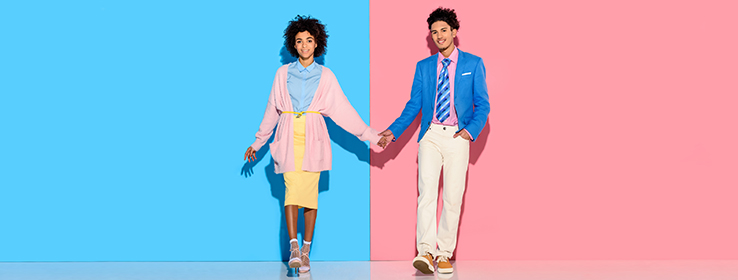Put on your rose-colored glasses and rethink pink.
For some, thinking about pink brings up images of sparkly little girl party dresses. For others, it’s about voicing political power. What does pink do for you? Your view might change after you discover more about the power of pink.
(Not) for Girls Only
The old adage is “pink is for girls, blue for boys.” But that hasn’t always been the case. Prior to World War II, it was very common to see little boys wearing pink (the lighter shade of red — a powerful color) and little girls wearing blue (traditionally symbolizing the Virgin Mary).
Eton College men battled for the coveted pink rowing jersey. And babies at the time were usually swaddled in white. That all changed after the war. There are many theories about why pink became the color for girls and blue for boys, but one of the most compelling reasons points to mass marketing. In the very binary world of the 1950s, it was easier to sell lipstick or shaving cream to gender-defined audiences, and visual color codes helped.
The gender color assignment notion is changing, however. For instance, pink has been solidly entrenched in men’s fashion for over a decade. Current style influencers suggest pastel pink as the color for fashion-savvy men in 2019. And both the 2019 Oscars and Grammys saw plenty of pink suits strolling down the red carpet.
Pink Power
The color pink isn’t relegated to just fashion — it has become an emblem for cause-driven organizations. They have used the color widely and publicly as a symbol for equality, diversity and women’s access to healthcare, among other causes. The most iconic example of this use of pink is the pink ribbon of the breast cancer awareness movement.
Prison Pink
Another look at pink brings us to prison, of all places.
In 1979, researcher Alexander Schauss theorized that a very specific type of pink could reduce aggressiveness in male prisoners. Dubbed “Baker-Miller Pink” or “Drunk Tank Pink,” the shade was used on the ceiling, walls and barred doors at a U.S. Navy correctional facility in Seattle.
The Navy witnessed fewer acts of violence at first, but it was later found that the effect was only temporary. In some cases, when it was used in other prisons, inmates became more aggressive after being exposed to the bubble gum shade. In any case, the research showed that pink has a strong emotional effect.
A Pink Experiment
Researcher Alexander Schauss claimed that Baker-Miller Pink not only created changes in the mind but changes in the body. He tested his theory on himself by staring at a large card printed in the color after he exercised. He found that his heart rate lowered considerably while staring at Baker-Miller Pink as opposed to other colors.
The Color of a Generation
“Millennial Pink” or “Tumblr Pink” is a salmon-rose color that hasn’t lost any steam, despite its wild popularity starting in 2017. It’s said to be inspired by the kitschy vibe of Wes Anderson’s The Grand Budapest Hotel, the rose-gold iPhone and even Kim Kardashian’s 2013 makeover.
It’s easy to see why this shade has continued to be in favor, though. It’s a versatile pastel that’s warm and happy but not too sickly sweet. Plus, this pink makes any skin tone look fantastic.
Designing With Millennial Pink
Sherwin-Williams Director of Color Marketing Sue Wadden agrees that Millennial Pink — a soft, warm neutral — picks up where beige left off a decade ago. It can in many ways be used as a neutral. Learn more about designing with Millennial Pink and find some palette suggestions here.













